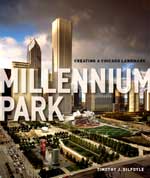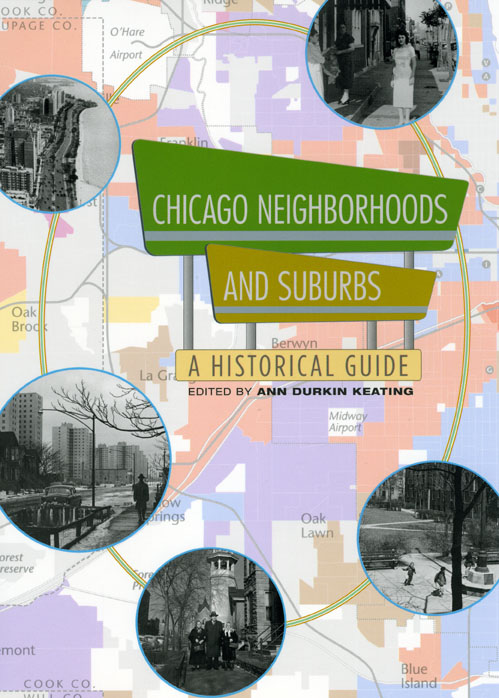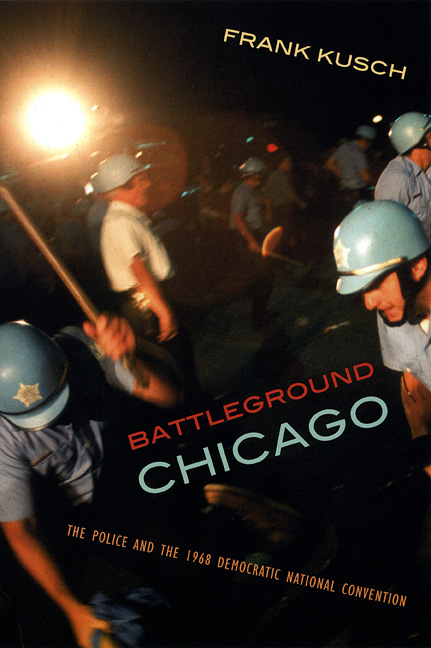The City of Obama — Grant Park and Chicago
Last night, an estimated quarter of a million people (your humble and hopeful correspondent included) gathered in Grant Park to celebrate the election of our nation’s 44th president, Barack Obama. While the spotlight undoubtedly shined brightest on the man who will become our first African-American commander-in-chief, the city of Chicago—and its diverse and dedicated citizenry—was also on glorious display. As we bask today in the afterglow of a historic victory and a safe and successful rally (it was, as the Chicago Sun-Times reports today, a “Night for dancing, not trouble, in the streets“), we offer you a reading list for those who couldn’t join us on our city’s “front lawn.”
 Though from the air, it may have appeared that all of Grant Park was teeming with revelers last night, a section just north of the camera’s view was quiet as a museum after visiting hours–and a museum is just one way to describe the incredible space. In 2004, a nearly 25-acre parcel of northern Grant Park, which was previously occupied by an unused railroad yard and parking lots, was remade into the whimsical and inspiring Millennium Park. Part park, part outdoor art museum, part cultural center, and part performance space, the park is now an unprecedented combination of distinctive architecture, monumental sculpture, and innovative landscaping; it includes structures and works by Frank Gehry, Anish Kapoor, Jaume Plensa, and Kathryn Gustafson, among others. Timothy J. Gilfoyle’s 2006 biography of the park Millennium Park: Creating a Chicago Landmark is every bit as breathtaking as its subject: loaded with more than 350 eye-popping photos, it brings the astonishing urban oasis into tactile focus for anyone who wants to travel to Chicago without leaving their favorite reading nook.
Though from the air, it may have appeared that all of Grant Park was teeming with revelers last night, a section just north of the camera’s view was quiet as a museum after visiting hours–and a museum is just one way to describe the incredible space. In 2004, a nearly 25-acre parcel of northern Grant Park, which was previously occupied by an unused railroad yard and parking lots, was remade into the whimsical and inspiring Millennium Park. Part park, part outdoor art museum, part cultural center, and part performance space, the park is now an unprecedented combination of distinctive architecture, monumental sculpture, and innovative landscaping; it includes structures and works by Frank Gehry, Anish Kapoor, Jaume Plensa, and Kathryn Gustafson, among others. Timothy J. Gilfoyle’s 2006 biography of the park Millennium Park: Creating a Chicago Landmark is every bit as breathtaking as its subject: loaded with more than 350 eye-popping photos, it brings the astonishing urban oasis into tactile focus for anyone who wants to travel to Chicago without leaving their favorite reading nook.
 Chicago is often described as a city of neighborhoods. In sports, there is a famous schism that pits South Siders against North Siders. But in Grant Park on election night, the divisions that characterize our city melted away and for a glorious few hours we were all simply Chicagoans. After the rally, however, the crowds dispersed to the various corners of the city. If you wondered where everyone came from and where they went home to afterward, look no further than Ann Durkin Keating’s new Chicago Neighborhoods and Suburbs: A Historical Guide. With 230 neighborhoods and 77 official community areas, the city of Chicago is an expansive metropolis carved into small hamlets with distinct personalities and persons. Now that the city’s residents have gone home from the park, Keating’s book will help anyone interested in urban demography and history understand what divides us—and brings us back together again.
Chicago is often described as a city of neighborhoods. In sports, there is a famous schism that pits South Siders against North Siders. But in Grant Park on election night, the divisions that characterize our city melted away and for a glorious few hours we were all simply Chicagoans. After the rally, however, the crowds dispersed to the various corners of the city. If you wondered where everyone came from and where they went home to afterward, look no further than Ann Durkin Keating’s new Chicago Neighborhoods and Suburbs: A Historical Guide. With 230 neighborhoods and 77 official community areas, the city of Chicago is an expansive metropolis carved into small hamlets with distinct personalities and persons. Now that the city’s residents have gone home from the park, Keating’s book will help anyone interested in urban demography and history understand what divides us—and brings us back together again.
 When the Obama camp first announced its plan to hold an election night rally in Grant Park, it was heralded as a bold move that would finally exorcise the ghosts of the 1968 Democratic National Convention and the violence that transpired in that space 40 years ago. Frank Kusch’s Battleground Chicago: The Police and the 1968 Democratic National Convention revisits that dark chapter in American history.
When the Obama camp first announced its plan to hold an election night rally in Grant Park, it was heralded as a bold move that would finally exorcise the ghosts of the 1968 Democratic National Convention and the violence that transpired in that space 40 years ago. Frank Kusch’s Battleground Chicago: The Police and the 1968 Democratic National Convention revisits that dark chapter in American history.
 Finally, for anything not covered in the books above, consider thumbing through the comprehensive Encyclopedia of Chicago. Comprising more than 1,400 entries, the Encyclopedia covers the full range of Chicago’s neighborhoods, suburbs, and ethnic groups, as well as the city’s cultural institutions, technology and science, architecture, religions, immigration, transportation, business history, labor, music, health and medicine, and hundreds of other topics.
Finally, for anything not covered in the books above, consider thumbing through the comprehensive Encyclopedia of Chicago. Comprising more than 1,400 entries, the Encyclopedia covers the full range of Chicago’s neighborhoods, suburbs, and ethnic groups, as well as the city’s cultural institutions, technology and science, architecture, religions, immigration, transportation, business history, labor, music, health and medicine, and hundreds of other topics.
And for more books about Chicago, check out of expansive list of regional titles with national interest.
As president-elect Obama gets to work assembling his administration, we hope you take some time to get to know the city that was so instrumental to his ascent. Chicago, at least last night (though we would argue it always is), was the most exciting place to be in America.